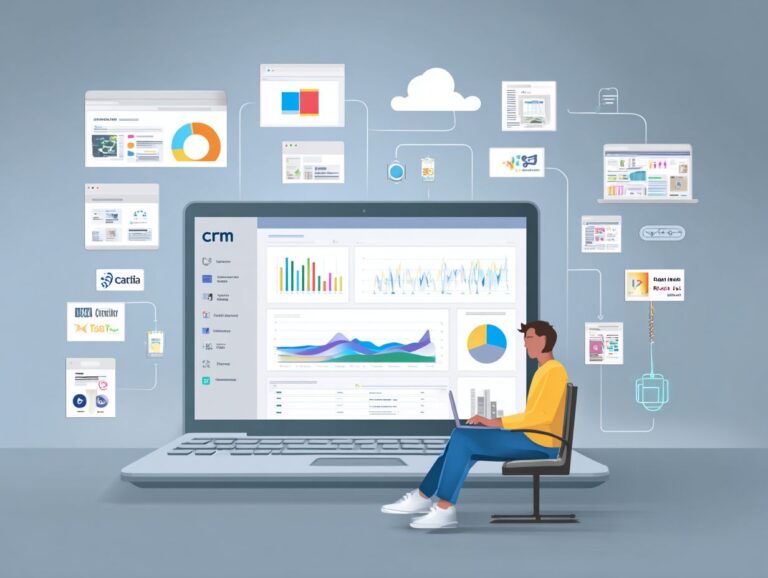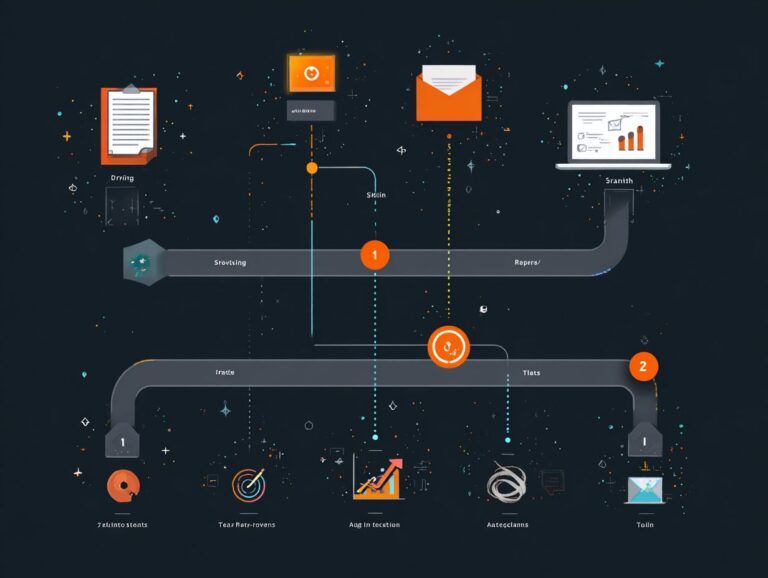How to Improve Customer Visibility with CRM Integration: Strategies
In the current competitive market, connecting CRM systems is important for improving how we see customers all through their buying process. By using tools like SuperOffice and AI, companies can get helpful information to improve customer relationships. This article will look at practical ways to smoothly bring CRM systems into your business, helping you get the most out of your customer interactions for better results. Learn how to improve your business with better exposure and more effective interaction.
Key Takeaways:
- Connecting CRM systems can significantly enhance your access to customer data, resulting in better clarity and more effective communication with your customers.
- Using strategies like bringing data together in one place and analyzing it instantly is important for connecting CRM systems and getting a clearer view of customers.
- Businesses can improve customer interactions and succeed by making them more personal and using different ways to communicate. This helps them understand customers better.
- Understanding Customer Visibility
- Key Strategies for CRM Integration
- Enhancing Customer Interactions
- Measuring Success
- Frequently Asked Questions
- 1. What is customer visibility and why is it important?
- 2. How can CRM integration help improve customer visibility?
- 3. What are some key strategies for improving customer visibility with CRM integration?
- 4. What are the benefits of having a high level of customer visibility?
- 5. What steps can businesses take to keep customer data correct and safe in their CRM system?
- 6. What are some potential challenges businesses may face when implementing CRM integration for customer visibility?
1. Definition and Importance

CRM integration is the process of combining customer data from different systems to improve sales efficiency and customer interaction. This combination improves data accuracy, so sales and marketing teams have access to current information.
Linking CRM tools like Salesforce with marketing platforms like HubSpot enables easy sharing of information, which helps customize communication for each person.
Using middleware solutions like Zapier can handle tasks between apps automatically, cutting down on manual entry and mistakes.
Businesses can build better customer connections and improve their internal procedures, leading to growth and improved performance.
2. Overview of Customer Visibility
Knowing how customers act and choose at each point of contact is important for creating customized marketing and service plans. This clarity allows businesses to make informed choices by studying customer actions and likes.
For example, using CRM tools like Salesforce or HubSpot helps businesses follow customer interactions from the first contact to after-sales support, spotting patterns and areas for improvement.
By using customer feedback and engagement data, companies can better tailor their services, which helps keep customers and makes them happier.
Using tools like Google Analytics can help you learn more about how customers act, which in turn helps create targeted marketing campaigns and improve services. See also: Mastering Customer Feedback Management for a deeper understanding of integrating feedback into strategic improvements.
Understanding Customer Visibility
Seeing customer actions and needs is an important part of CRM. It helps create better ways to connect with customers.
1. What is Customer Visibility?
Customer visibility is defined as the capability of organizations to access and analyze customer data across different stages of their lifecycle, from lead generation to post-sale support.
This feature is key to improving the customer experience and can be done with tools like Salesforce, HubSpot, or Zoho CRM. These platforms combine customer data to show purchase history, likes, and communication details.
HubSpot’s analytics tools help businesses track customer interactions, enabling them to develop customized marketing plans. Creating a central customer database improves communication, allowing teams to respond quickly to questions and customize services for each person, resulting in a smoother customer experience.
2. Advantages of Better Customer Awareness
Improving how customers see and understand services can lead to 15% higher satisfaction and increase retention by 10%, promoting long-term loyalty.
For example, businesses that use customer relationship management (CRM) tools, like Salesforce or HubSpot, can monitor interactions instantly, allowing for customized communication.
Using tools like Google Analytics helps businesses understand how customers act, enabling them to adjust their marketing strategies.
A retail brand, for example, increased its repeat purchase rate by 20% after implementing targeted email campaigns based on customer preferences gathered through these tools. This approach strengthens relationships and increases customer loyalty.
Key Strategies for CRM Integration

To successfully integrate a CRM system, focus on organizing data in one place and using immediate data analysis to improve how you interact with customers. Understanding the benefits of overcoming CRM integration challenges is crucial for a streamlined process and better customer visibility.
1. Data Centralization
Data centralization involves consolidating customer information from disparate sources into a unified database, improving data synchronization and enhancing sales intelligence.
To achieve effective data centralization, begin by selecting integration tools like HubSpot and Salesforce for their powerful API capabilities. Start by mapping out all data sources, such as email platforms, CRMs, and social media.
Next, use HubSpot’s integration features to connect your various tools; for instance, the Salesforce integration allows you to sync contacts and leads seamlessly.
After integration, establish data governance practices to maintain accuracy and consistency, including regular audits and access controls. This method makes your data clearer and improves how your operations run.
2. Real-Time Analytics
Organizations can watch customer interactions in real-time, giving important information for quick decisions and long-term strategies.
To implement real-time analytics within a CRM setup, start by integrating Google Analytics to track user behavior and engagement on your site. Pair this with Tableau for visualizing data trends.
Focus on key metrics such as:
- Customer acquisition cost
- Lifetime value
- Churn rate
By setting up custom dashboards in Tableau, you can quickly assess performance. Check these numbers often to change your marketing plans as things happen. This helps you meet customer needs and get the most out of your investment.
Curious about how key CRM metrics and real-time analytics can enhance strategic decisions? Our detailed exploration explains their impact.
Enhancing Customer Interactions
Improving customer interactions by using specific methods and various communication channels can greatly increase participation. As part of this approach, understanding the nuances of customer experience management can be particularly beneficial (explore our guide on effective customer experience marketing for insights).
1. Personalization Techniques
Using methods like specific email promotions and custom content suggestions can raise customer attention by up to 20%. Use CRM tools such as HubSpot or Salesforce for successful strategy execution, as they offer thorough customer information.
For targeted email campaigns, segment your audience based on behavior, such as past purchases. For example, if a customer regularly buys fitness gear, send them exclusive content about new arrivals in that category.
Tools like Optimizely can create customized website experiences using user data, presenting relevant products or articles, boosting user satisfaction and raising conversion rates.
2. Omni-Channel Communication

Having a communication plan that includes all channels ensures consistent messages across platforms and matches customers’ preferred ways of communication.
To handle this strategy, use CRM tools such as HubSpot or Salesforce. Begin by mapping customer touchpoints across channels-email, social media, and live chat.
Next, set up automatic processes to keep things moving quickly; for instance, HubSpot’s ticketing system can organize and speed up replies to support questions.
Employ analytics to assess engagement metrics on each platform, adjusting your approach as needed. Companies like Zappos do well at clear communication by using specific messages, making sure that customer experiences are consistent and personal across all platforms.
Measuring Success
Measuring success in CRM integration means finding specific metrics that show how customer engagement and satisfaction have improved.
1. Key Performance Indicators (KPIs)
Key Performance Indicators (KPIs) such as customer satisfaction scores and lead conversion rates are essential for evaluating CRM success. To keep track of these KPIs, use tools like HubSpot to follow lead conversion rates that indicate the percentage of leads becoming customers.
For customer satisfaction scores, consider using SurveyMonkey to send surveys post-interaction, providing instant feedback.
Engagement metrics, such as email open and response rates, can be tracked through CRM features in platforms like Salesforce. By regularly checking these KPIs, you can spot trends, make informed decisions to strengthen customer relationships, and boost sales.
2. Feedback and Continuous Improvement
Gathering and reviewing feedback often is key for ongoing improvement. It helps organizations keep their CRM strategies current with changing customer needs. To collect customer feedback, use tools like SurveyMonkey to create surveys easily or use Zendesk to monitor support conversations.
For instance, Starbucks improved their CRM by implementing a mobile app that collects feedback in real-time, adjusting their services based on customer preferences. Sending follow-up emails after purchases can provide useful information.
Companies like Amazon use user reviews to improve products and make customer experiences better. Related insight: Ultimate Guide To Customer Feedback Strategy For Business. By thoroughly examining this data, businesses can identify where they can do better and turn customer feedback into practical plans.
Frequently Asked Questions
1. What is customer visibility and why is it important?
Customer visibility means being able to see and examine customer data, interactions, and behaviors to understand and improve customer relationships. It is important because it allows businesses to understand their customers better and tailor their strategies to meet their needs and preferences.
2. How can CRM integration help improve customer visibility?
CRM integration involves combining customer data from various sources into a central system. This helps businesses understand their customers better, which can then be used to increase customer awareness through data analysis and tracking.
3. What are some key strategies for improving customer visibility with CRM integration?
Some key strategies include setting clear goals and objectives for customer visibility, regularly updating and cleaning customer data, utilizing data analysis tools, and incorporating customer feedback into your CRM system.
4. What are the benefits of having a high level of customer visibility?
A high level of customer visibility can lead to improved customer satisfaction, increased cross-selling and upselling opportunities, better customer retention, and more effective marketing and sales strategies.
5. What steps can businesses take to keep customer data correct and safe in their CRM system?
To keep customer data accurate and safe, businesses need to have strong data management rules, frequently back up their data, and apply secure ways to connect their CRM systems. It is also important to train employees on proper data handling procedures.
6. What are some potential challenges businesses may face when implementing CRM integration for customer visibility?
Some challenges may include data compatibility issues, data privacy concerns, and resistance from employees who are not familiar with the CRM system. It is important to carefully plan and address these challenges before implementing CRM integration.





